Unearthing the Eocene’s Echo: The First Fossil Singing Cicada from Germany’s Messel Pit
By Anurag Maurya, Geoscience Writer | Geoprimex Organization
5/8/20254 min read

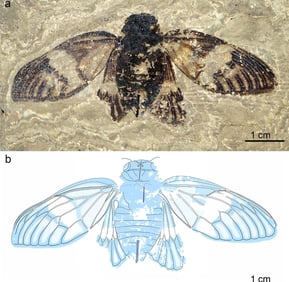
Introduction
The soft hum of cicadas is synonymous with summer in many parts of the world. But what if that familiar song echoes back not just decades, but nearly 47 million years? In a groundbreaking discovery published in Scientific Reports (2025), Jiang et al. report the oldest known fossil of a singing cicada, named Eoplatypleura messelensis, unearthed from the iconic Eocene-aged Messel Pit in Germany.
A Cicada Lost in Time
The fossil belongs to the tribe Platypleurini, a highly diverse and geographically widespread group of cicadas currently found across tropical and subtropical Asia and Africa. What makes Eoplatypleura messelensis remarkable is not only its exquisite preservation but also its significance as the first confirmed singing cicada fossil from the Eocene. This makes it the oldest definitive record of the subfamily Cicadinae anywhere in the world.
This discovery fills a critical gap in the cicada fossil record, bridging the knowledge void between Paleocene and Oligocene specimens. The specimen’s age, approximately 47.2 million years, predates current molecular estimates for the origin of its tribe by nearly 20 million years, suggesting a need to recalibrate the evolutionary clock for these remarkable insects.
The Messel Pit: A Window into the Past
The Messel Pit, a UNESCO World Heritage site in Hesse, Germany, is renowned for its fossil-rich oil shales. Once a maar lake formed by volcanic activity, the site preserves a subtropical forest ecosystem from the Eocene epoch. The climate reconstruction reveals warm mean annual temperatures (~22°C) and high humidity, conditions that mirror modern habitats of Platypleurini, suggesting a long-standing ecological preference for forested environments.
Anatomy and Identification
The two fossil specimens—adult females—were identified based on their wing venation, body morphology, and characteristic coloration patterns. Their wingspan ranges from ~58 to 68 mm. Notably, their forewings are broad and decorated with dark vein bands and hyaline patches—traits associated with camouflage in modern cicadas.
Advanced imaging techniques including microscopy, SEM, and digital reconstruction were employed to study the fossils, ensuring a robust taxonomic classification and highlighting the fine anatomical details preserved in the Messel sediments.
Evolutionary Significance
Molecular and fossil evidence once suggested the origin of the Platypleurini tribe at around 25–30 million years ago. However, the discovery of E. messelensis pushes this origin back by nearly 20 million years. This has profound implications for our understanding of cicada evolution, indicating that early diversification occurred during a time of global warmth and widespread forest habitats.
The authors propose three potential evolutionary scenarios: (1) E. messelensis represents a stem group of Platypleurini; (2) it belongs to the African forest lineage, implying earlier dispersal; or (3) it is a member of the Asian lineage, suggesting much earlier colonization of Eurasia than previously assumed.
Paleogeographic Implications
At the time E. messelensis thrived, the Messel region lay near 47°N latitude but experienced a subtropical climate. This suggests that Platypleurini cicadas once occupied a much broader geographic range than today. With global cooling and increasing aridity in the Oligocene, their distribution likely contracted to lower latitudes, aligning with their modern range.
Conclusion
The discovery of Eoplatypleura messelensis not only enriches the fossil record of cicadas but also challenges existing timelines of their evolutionary history. It underscores the significance of fossil calibration in molecular studies and the continued value of the Messel Pit as a paleontological treasure trove.
As new specimens emerge and phylogenetic techniques advance, this tiny songster from the Eocene may yet reshape our understanding of cicada biogeography, climate adaptation, and ancient acoustic landscapes.
Reference:
Jiang, H., Moulds, M. S., Blank, S. M., Rust, J., & Wedmann, S. (2025). Sounds from the Eocene: The first singing cicada from the Messel Pit, Germany. Scientific Reports, 15, Article 12826. https://doi.org/10.1038/s41598-025-94099-7
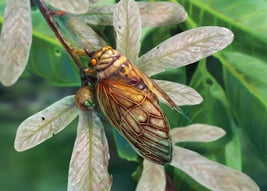


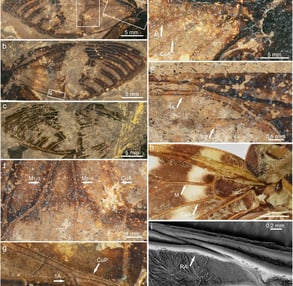
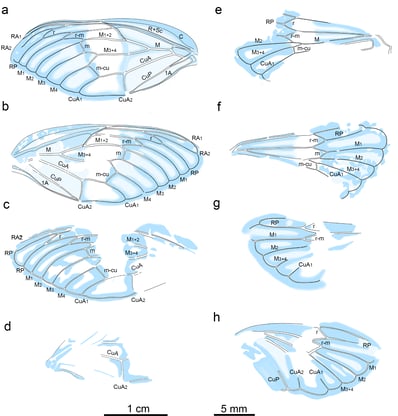

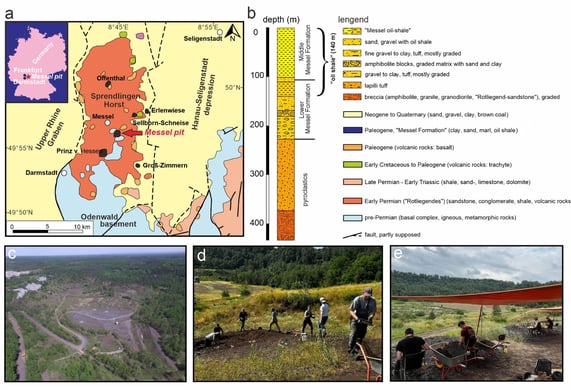

Eoplatypleura messelensis gen. et sp. nov., holotype, SF-Mel1515. (a) Photographic overview. (b) Overlay drawing overview
Overlay drawing of wing structures of Eoplatypleura messelensis gen. et sp. nov. (a), (b), (e) and (f) Holotype SF-Mel1515. (c), (d), (g) and (h) Paratype SF-Mel8954. (a) holotype left forewing. (b) holotype right forewing. (c) paratype right forewing. (d) paratype left forewing. (e) holotype left hingwing. (f) holotype right hindwing. (g) paratype right hindwing. (h) paratype left hindwing. Scale bar: (a–d), 1 cm; (e–h), 5 mm.
Reconstruction of Eoplatypleura messelensis gen. et sp. nov. from the Eocene Messel Pit, by Dinghua Yang
Fig. 3. (a) Geological map showing the location of the Messel pit in relation to other Paleogene sites on the Palaeozoic basement of the Sprendlinger Horst (modified after53, based54). (b) Generalised section of the Messel 2001 core (modified after53) displaying the major lithological units. (c) Aerial panoramic view of the Messel Pit, photo taken by Sven Tränkner. (d) Photo of fossil collection on-site, taken by Nicolas Adrian Stagg. (e) Photo of fossil processing on-site, taken by Loup Boudet
Forewing structures of Eoplatypleura messelensis gen. et sp. nov. and living species. (a), (b) and (d–f) Holotype SF-Mel1515; (c) and (g) Paratype SF-Me18054. (a) Holotype left forewing. (b) Holotype right forewing. (c) Paratype right forewing. (d) Showing basal part from (a). (e) holotype showing details of the area around node from (a). (f) Showing middle part of holotype forewing from (a). (g) Showing detail of terminals of CuP and 1 A from (c). (h) Showing details of the basal part of forewing of Planopleura kaempferi. (i) Showing details of the area around node of P. kaempferi, SEM image
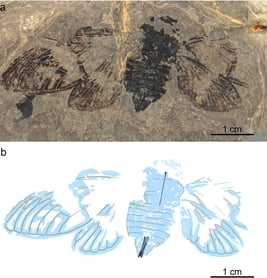

Eoplatypleura messelensis gen. et sp. nov., paratype, SF-Mel8954. (a) Photographic overview. (b) Overlay drawing overview
email: science@geoprimex.com
© 2024. All rights reserved.
Whatsapp: +919044995188
Contact Informaton
Important links
anuragmaurya80@gmail.com
